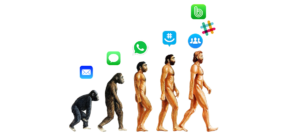We all know communicating as a group or a team can be pretty difficult. It gets even more complicated with larger groups of 50+ people or even larger organizations. That’s why it’s important to think about the tool that we use to talk, plan, and share with our group and whether it’s the best option available to us today. Most of us start out using email or SMS with our group members, which is fine at first but soon becomes a messy situation as conversations pile up. Here are 5 different apps you could be using with your group that are better than email or SMS.

1. WhatsApp
❏ Cost: Free
❏ Features: Group chat
❏ Ideal for: Friends, Family.
❏ Pros: Most people already have it on their phone, so it’s easy to convince your group to use it.
❏ Cons: Wasn’t made for group use for it lacks other useful group features like a calendar.
When your looking beyond email and SMS for private group communication, the first thing you can try is group chat. WhatsApp is a simple way to start a group chat with your group members. It’s an extremely popular messaging service so it’s likely your friends are already using it so it’ll be easy to convince them to use it for group communication. The downside is that apart from group chat there aren’t any features geared towards groups, such as a group calendar.

2. GroupMe
❏ Cost: Free
❏ Features: Group chat, Group Calendar with Reminders.
❏ Ideal for: Friends, Family, School projects, Clubs. (Small 3-5 people groups to 10-30 mid-size groups)
❏ Pros: User-friendly and Easy-to-Use; Nice calendar feature with reminders is very helpful.
❏ Cons: Thread becomes too long after a while; Larger groups easily get noisy and disorganized.
GroupMe is great for small to mid-size groups that need to communicate, make decisions, and schedule things together. If your group hasn’t tried a better communication tool than email or SMS, than GroupMe is a good place to start. However, keep in mind that although group chats are convenient, they can also get quite disorganized after a while with multiple conversations overlapping one another, especially in larger groups.

3. Facebook Groups
❏ Cost: Free
❏ Platform: iOS, And, Web (No stand-alone app)
❏ Features: Group chat, Group Calendar, Group Board, Group Albums.
❏ Ideal for: Friends, Family.
❏ Pros: If you’re a facebook user, the interface for groups will be easy to learn; Range of group features for more organized communication.
❏ Cons: There is no stand-alone app for groups, so it’s a bit of a hassle to access it on mobile through the main facebook app; If someone in your group doesn’t want to have a facebook account this is not an option.
Facebook Groups is loaded with all the group features you could ask for, but overall there are some major oversights. The biggest one I’ve experienced is that there’s always someone that refuses to have a facebook account. Then you can’t include that person in your facebook group which is a big problem. There’s also groups that you’d rather keep your social life private from, but with facebook you can’t do that. Another small issue is that without a stand-alone app for groups my notifications get mixed up with personal ones, which is a bit annoying.

4. BAND
❏ Cost: Free
❏ Features: Group chat, Group Calendar, Group Board, Group Albums, Group Voice Calling, Polls.
❏ Ideal for: Sports teams, Church groups, Work teams, School clubs.
❏ Pros: Comprehensive set of group features; Intuitive design; Reliable
❏ Cons: The name is kinda odd; it’s relatively unknown so you’ll have to explain it to your friends.
BAND is an up-and-coming group service that really started gaining popularity this year. It’s an app that was designed for group communication from the start so it has all the features a group could ask for, and the great thing about BAND is that it listens to it’s users and keeps getting upgraded. BAND is a relatively unknown app in the states, but globally there has been 80+ million downloads. The only downside to this app seems to be it’s name which I always end up explaining to my friends. “It’s called band, as in rubber band.”

5. Slack
❏ Cost: Free for Basic, $8 per user/month for Standard plan, $15 for Plus plan
❏ Features: Group chat, Channels by topics, Third-party integration support, Co-authoring documents.
❏ Ideal for: Work teams. Project teams.
❏ Pros: Easy to share files with your team; Sophisticated interface; All contents are searchable.
❏ Cons: You need to add third party apps manually (like Google Calendar for scheduling); You need to subscribe to a paid plan for larger file storage and advanced features.
Slack is currently the most popular service for internal team communication. If you want to manage your team’s deadlines and workflows then Slack is a good tool to consider adopting. The ability to co-author documents with coworkers is also very useful. But Slack provides a limited file storage of 5GB for the Free Basic plan, which gets used up pretty soon so you would need to consider budgeting for paid plans.
Last word
When you’re picking a group communication tool, you should consider a few things. First, you should think about the size of your group and choose a tool that is a good fit. Small groups of 3-5 people can get by with group chat alone, but mid-size groups (10-30+ people) and large-size groups (50-100+) should definitely go with an app like BAND or Slack to keep things organized. Second, you should consider which tool is best suited for your specific type of group (sports teams, work teams, school groups, etc.). Lastly, you need to keep in mind that once your group chooses a tool, you’re likely to use it for the long term. Therefore, try to choose an option that wouldn’t give you roadblocks in the long run. For example, if you choose a service with only a few features and later end up needing more, it would be better to choose one that has everything from the start. Also, if you start out using a service for free and later end up needing to go premium and pay a monthly fee, that should be considered from the start.








